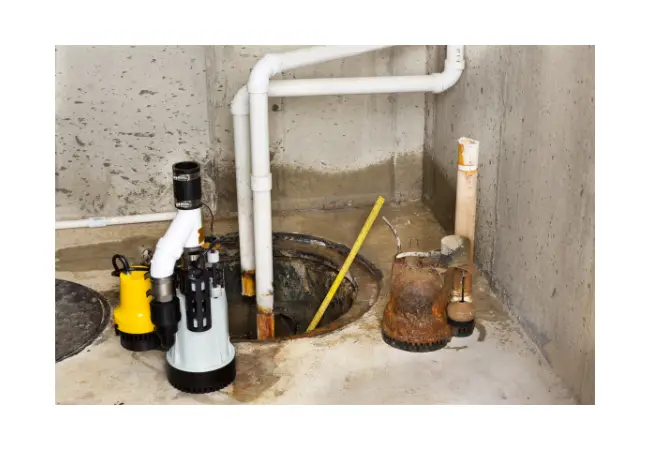Last Updated on June 1, 2023 by admin
When it comes to figuring out how to hide sump pump discharge pipes, there are certain ways and rules you should be aware of. For example, one of the most well-followed sump pump discharge rules is to keep the very end of the pipe away from the lot line, for at least 5 feet. Of course, you don’t want the discharge line to be visible because aesthetics are important. And today, we will be focusing on that mainly.

Table Of Contents
- 1 The Basics of How to Hide Sump Pump Discharge Pipe
- 2 Here’s What You Need to Do Next
- 3 Some Really Working Sump Pump Discharge Ideas You Should Know About
- 4 Precautions to Take When Hiding a Sump Pump Discharge Pipe
- 5 Frequently Asked Questions
- 5.1 How can I hide my sump pump discharge pipe?
- 5.2 Can I bury my sump pump discharge pipe?
- 5.3 What kind of paint should I use for my sump pump discharge pipe?
- 5.4 Can landscaping help hide a sump pump discharge pipe?
- 5.5 Are there any legal regulations when rerouting or hiding a sump pump discharge pipe?
- 5.6 How Often Should a Sump Pump Run?
- 5.7 How can I disguise my sump pump discharge pipe in my yard?
- 5.8 Can I reroute my sump pump discharge pipe?
- 5.9 Is it possible to bury the sump pump discharge pipe underground?
- 6 Conclusion
The Basics of How to Hide Sump Pump Discharge Pipe
When seeking to hide a sump pump discharge line, it is crucial to prioritize maintaining its functionality. The primary role of this drain pipe is to channel water away from your basement or crawl space and prevent flooding. If any modifications impede the sump pump discharge pipes’ ability to perform this role, the results could be catastrophic. Water damage can lead to significant structural issues in a home, leading to expensive repairs. Therefore, while aesthetics are important, they should not compromise the effectiveness of your sump pump system. Any camouflage or decorative elements should be implemented with careful consideration to ensure that the pipe’s function isn’t compromised.
There are several methods available for homeowners seeking to hide a sump pump drain. Each method has its advantages and requirements, and the best choice largely depends on your specific circumstances, including your home’s layout, your climate, and your aesthetic preferences.
Landscaping, for example, uses strategic planting to obscure the PVC pipe, making it a great option for those with a green thumb or an eye for garden design. Decorative rocks and stones, on the other hand, offer a low-maintenance solution that can seamlessly blend with the surroundings. External structures such as fences, walls, or sheds can provide substantial coverage for your discharge pipe while also serving other functional or aesthetic purposes. Lastly, painting the pipe to match its surroundings can make it less noticeable, but requires a careful selection of suitable paints.
It’s essential to explore these options and understand their requirements to choose the most suitable method for your needs.
Here’s What You Need to Do Next
The male pipe adapter needs to be fixed with the PVC pipe through glue and then place inside the female adapter that should be coming from the discharger. There must be a huge pipe bit sticking out. 1.25- or 1.5-inch diameters are commonly working with most pipes.
You need to drill a weep hole that keeps bursts aside, simply drill one that’s quarter-inch right 6 inches above the pipe. You can skip doing so if there’s already one or maybe the discharge is outside.
Install the check valve after making a weep hole with a hacksaw. Then make the rubber bearing stick tightly to the pipe using a screwdriver. A discharger that has a check valve, won’t need it. simply make a 90-degree angle then. For the twist, PVC pipes that are flexible work as well.
Make a deep trench using a shovel for the route. The depth will help in hiding the pipe seamlessly. Be very careful not to end up digging gas lines. Then fix the discharge to route as well as extra PVC pipes. The water flow should be steering away from your place. PVC cement is a great glue for attaching. The 90-degree bent joint is where you start. Get rid of pipes with a hacksaw that you don’t want. The discharger should be close to the ground.
Use dirt to cover the trenches once the sump pump pipe is settled. Sod laying also helps in case you have tough issues with the lawn.
Some Really Working Sump Pump Discharge Ideas You Should Know About

Landscaping
Landscaping provides a natural and aesthetically pleasing way to hide your sump pump discharge pipe. Select a variety of plants such as shrubs, ornamental grasses, or flowering perennials, to obscure the pipe. Consider using plants with different heights and spread to fully cover the area. Always remember to choose plants that will thrive in your specific climate and soil conditions to ensure they remain healthy and effective in hiding the sump pump line.
Incorporating the sump pump discharge hose into your garden design is another excellent way to make it less noticeable. Position the pipe strategically within the landscape design, using it as part of a rock garden, a water feature, or as the center of a circular flower bed. With a little creativity, the pipe can become an integral and even interesting feature of your garden rather than an eyesore.
Decorative Rocks and Stones
Decorative rocks and stones provide a simple yet effective solution for concealing a sump pump discharge pipe. Arrange larger rocks around the base of the pipe, using smaller stones and pebbles to fill in gaps and provide a seamless blend. This approach not only hides the pipe but also creates an interesting focal point in your garden or yard.
When using rocks and stones for camouflage, choose types that match or complement the existing landscape. Consider the color, size, and texture of the rocks in relation to your yard’s overall aesthetic. From river rocks to granite, there are many options to suit various landscaping themes.
External Structures
Erecting a small fence or wall around the pipe can effectively obscure it from view. Whether you choose a wooden picket fence, a brick wall, or a lattice panel, ensure it blends well with the existing architecture and landscaping of your home.
Another option is to incorporate the pipe into an existing structure such as a shed or garage. This could involve rerouting the pipe to discharge behind or alongside the structure, making it less visible. Ensure that any changes to the pipe’s routing still allow for effective water drainage and do not breach any local building regulations.
Pipe Painting
When deciding to paint the sump pump discharge pipe, it’s important to select the right paint. The paint should be suitable for the material of the pipe, usually PVC, and should be weather-resistant to withstand exposure to the elements. Colors that blend with your home’s exterior or the surrounding landscape will make the pipe less noticeable.
Once you’ve selected the right paint, consider techniques to blend the pipe further with its surroundings. For instance, if the pipe is against a brick wall, a faux brick finish might be effective. If it’s amongst the greenery, consider a green color or a camouflage pattern. The goal is to make the pipe visually merge with its surroundings as much as possible.
Precautions to Take When Hiding a Sump Pump Discharge Pipe
The primary role of your sump pump discharge hose is to carry water away from your home to prevent flooding. As such, it’s imperative that in your efforts to hide it, you do not compromise its functionality. Ensure that the pipe remains unobstructed and that its slope and direction effectively channel water away from your home. Be cautious when using methods that may potentially impede the water flow, such as placing large rocks or plants too close to the pipe’s outlet.
Regular check-ups and maintenance of your sump pump discharge pipe are crucial to its performance and longevity. Hidden or not, it’s important to routinely check the pipe for clogs, leaks, or signs of wear. During winter, check for ice buildup that may block the pipe. If the pipe is hidden within the foliage, regularly trim plants to prevent them from interfering with the pipe. By ensuring the pipe is in good condition, you reduce the risk of unexpected failure or flooding.
Lastly, always take into account the legal regulations governing the installation and modification of the sump pump drainage system rules in your area. When rerouting your sump pump discharge pipe or making significant changes to its setup, ensure you are compliant with local building codes and regulations. This may involve checking with your local municipal office or consulting with a professional. Non-compliance could lead to penalties, and more importantly, could potentially result in a system that doesn’t effectively prevent flooding.
Frequently Asked Questions
How can I hide my sump pump discharge pipe?
There are several methods to hide a sump pump discharge pipe, including landscaping techniques, using decorative rocks or stones, installing external structures like fences or walls, and painting the pipe to blend with its surroundings. However, remember to ensure that these hiding methods don’t interfere with the functionality of the discharge pipe.
Can I bury my sump pump discharge pipe?
Yes, you can bury your sump pump discharge pipe, but it must be done correctly to prevent issues such as freezing or clogging. Make sure to use a solid pipe, not a perforated one, for buried sections, and ensure that the pipe is sloped correctly to facilitate water flow away from your home.
What kind of paint should I use for my sump pump discharge pipe?
When painting a sump pump discharge pipe, typically made from PVC, use a paint that adheres well to plastic surfaces. The paint should also be weather-resistant to withstand various outdoor conditions. Match the color to your house or surrounding landscape for best concealment.
Can landscaping help hide a sump pump discharge pipe?
Yes, landscaping is an effective and natural way to hide a sump pump discharge pipe. You can use plants, shrubs, or decorative rocks to camouflage the pipe or integrate the pipe into a garden design, such as a rock garden or flower bed.
Are there any legal regulations when rerouting or hiding a sump pump discharge pipe?
Yes, legal regulations vary by local and state jurisdictions. You must ensure that any modifications to your sump pump system, including rerouting the discharge pipe, comply with local building codes and regulations. Always consult with a professional or your local municipal office when making significant changes to your home plumbing system.
How Often Should a Sump Pump Run?
How can I disguise my sump pump discharge pipe in my yard?
There are multiple methods to effectively hide a sump pump discharge pipe in your yard. Landscaping solutions such as strategic plant placement or creating a rock garden around the pipe can help it blend in with the environment. You can also use decorative rocks and stones, install fences or walls, or even paint the pipe to match the surrounding area.
Can I reroute my sump pump discharge pipe?
Yes, you can reroute your sump pump discharge pipe, but it should be done carefully to ensure that the pipe continues to effectively drain water away from your house. Additionally, local codes and regulations often dictate how and where you can discharge the water, so it’s important to check these before making changes.
Is it possible to bury the sump pump discharge pipe underground?
Burying a sump pump discharge pipe is an option, but it needs to be done correctly to avoid potential problems. A buried pipe should be sloped properly to ensure effective drainage, and it should be a solid pipe, not perforated, to prevent clogging.

Conclusion
Throughout this article, we’ve explored a variety of ways to conceal a sump pump discharge pipe. These include the use of landscaping techniques, applying decorative rocks or stones, integrating external structures such as fences or walls, and using specific painting strategies. Each of these methods has its own set of advantages and can be implemented depending on your individual preferences and the existing aesthetic of your home.
While we strive for aesthetic solutions, it is important to emphasize that the functionality of your sump pump drainage pipe should never be compromised. Despite our efforts to hide the pipe, it must remain fully operational, effectively directing water away from your home. Always bear in mind that any aesthetic measures should work harmoniously with the primary function of the discharge pipe, which is to prevent flooding and water damage.
Finally, remember that the methods mentioned here are just starting points. The actual execution of hiding a sump pumps discharge pipe invites room for creativity and personalization. You are encouraged to come up with unique and innovative ways that will not only conceal the pipe but also add a personal touch to your home’s exterior. Be it a specific arrangement of plants, a unique rock design, or a distinctive paint job, your unique solution can add character to your space while effectively hiding your sump pump discharge pipe.
So that was our thoughts on how to hide sump pump discharge pipe plus a few ideas that will make it more useful as a guide. You can now probably get an idea of what to do next with the discharge pipe and make it hide.
